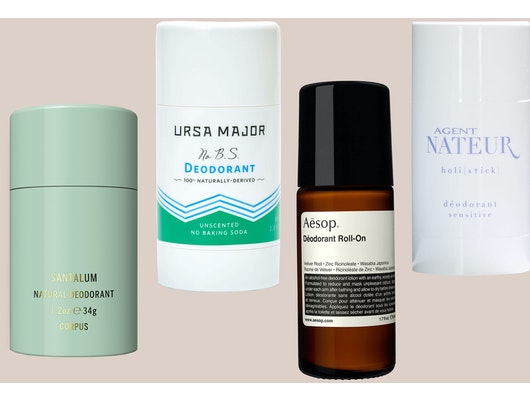7 Things to Know Before You Transition to a Natural Deodorant
[email protected] | July 27, 23

For years, people have been urging me to get on the natural deodorant train with fear-mongering about chemicals and toxins — and all it did was make me clutch my favorite antiperspirant tighter. Chemicals are everywhere and unavoidable. Sometimes, it seems like there’s nothing left in the world that couldn’t potentially cause cancer.
But I wasn’t only skeptical of the notion that natural is always superior. The truth is, I was terrified that if I gave up antiperspirant, I’d immediately revert to my pre-teen years, when I would sweat so heavily I’d carry an extra shirt in my bookbag every day as backup. Thankfully, I grew out of that (doctors said it was related to puberty and hormones going haywire), but I didn’t want to test my luck.
Then I started working freelance from home, and my entire routine changed dramatically. I’d go days without shampooing and a week without makeup or shaving. And for the first time, I figured I might as well see what all the natural deodorant fuss was about . . . considering no one would be around to smell me.
I didn’t go cold turkey — it was holiday party season, after all — but I wore natural deodorant four to five days a week throughout the month of December. My body finally began to adjust towards the last few days of 2018. I wasn’t sweaty, but I certainly didn’t smell like a fresh flower. The biggest upside I noticed is that my underarms were softer and smoother, free of ingrowns and bumps.
Though I enjoyed my experiment with natural formulas, I don’t personally plan on fully switching over (old habits die hard). I’m not totally ditching them — they’re a nice alternative to have on days when I’m not active and don’t want to clog my sweat glands with aluminum. If I can come around on clean deodorant, so can you. That said, there are a few things I wish I’d known before making the transition. Here are seven facts, tips, and tricks to learn before switching over to natural deodorant.

Stocksy United / Guille Faingold
First things first: There is no scientific evidence definitively linking aluminum-containing antiperspirants to breast cancer.
You’ve no doubt heard the persistent rumor that the aluminum-based compounds used in antiperspirants (traditionally applied under the arms near the breasts) have the potential to be absorbed by the skin and act as endocrine disruptors, leading to the development of breast cancer. It’s why many decide to switch to natural deodorant in the first place — but it’s a myth.
According to the American Cancer Society and the National Cancer Institute at the National Institutes of Health, there is little evidence to support the claim that antiperspirants increase the risk of breast cancer. Moving away from aluminum can be beneficial for other reasons, but if you absolutely can’t imagine a life without antiperspirant, chances are you’ll be just fine.
A reminder: Natural deodorant isnotantiperspirant.
The two terms get thrown around interchangeably, but it’s important to remember that deodorant helps to prevent body odor, not sweating, while chemical antiperspirants work to block wetness by plugging the sweat glands with aluminum compounds. Aluminum is the only ingredient recognized by the FDA as an antiperspirant, so if you read “aluminum-free antiperspirant” on a natural brand’s label, take it with a grain of salt.
The cancer fear isn’t the only reason to go natural.
Just because antiperspirants aren’t linked to breast cancer doesn’t mean they’re great for you. Consider the microbiome, says Beverly Hills dermatologist Dr. Ava Shamban: “There is a thriving colony of bacteria on our skin that effectively helps maintain the health of skin. Natural deodorant can [help] re-establish this balance that may have been disrupted by a chemical antiperspirant.”
The most obvious sign that you may want to switch from fragrances and gland-blocking compounds in chemical deodorants is a rash or bumpiness under the arms. It could be allergies which can clear up as soon as you find the natural deodorant that works for your body chemistry.
All ingredients are not created equal.
Dr. Shamban says there are typically three categories of ingredients in natural deodorants. The first is oil (usually tea tree or coconut) which acts as a natural antibacterial agent. There will also be an absorbent, most commonly baking soda, tapioca, or arrowroot, for perspiration. Lastly, there’s fragrance, like lavender or orange. But not everyone reacts well to certain essential oils and baking soda, especially in high concentrations, so make sure to do a patch test and watch for redness the first week.
If you find that you and your armpits need more delicate care, look for formulas developed without some of these potentially reactive ingredients: Ursa Major® No. B.S.TM Deodorant ($18) is both unscented and baking soda-free, and Agent Nateur® Holi (Stick)TM Sensitive ($28) is ideal for the irritation-prone thanks to its use of avocado oil and arrowroot powder (in lieu of baking soda).

Natural deodorant tends to be more expensive.
Mass brands haven’t quite caught up with the natural movement, which means that the majority of natural deodorants are made by niche, privately-owned companies. They often can only be purchased online or at specialty retailers, which tends to translate to a higher price point. Throughout my experiment in the category, I found the star products were Aesop® Deodorant Roll-On ($35) and Corpus® No Green Natural Deodorant ($22). Both dried down quickly and masked most of the odor (even after a hike) with woody floral scents.
You should prep your underarms for the transition.
Decades of using gland-blocking chemical antiperspirant and irritating hair follicles through shaving and waxing can result in underarm skin with bumps and product buildup that will make the transition to natural deodorant a long one. Get ahead of things and draw out impurities with Lavanila Laboratories® The Healthy Underarm Detox Mask ($26). The formula contains active charcoal, malic acid, and silica to help clarify the area. Twice a week, apply an even layer to clean, dry pits, wait five minutes (with your arms above your head, it’ll feel like 30 minutes), then rinse.
The adjustment period is real — and it’s not pretty.
The “detox” aspect of the transition from antiperspirant to natural deodorant refers to the initial amount of time, according to Dr. Shamban, the aluminum plugs loosen from the glands and release a heavier flow of sweat. Sweat on its own is odorless; the musky, B.O. smell results when it reacts with the bacteria on your skin. Since you’re perspiring more until your body’s microbiome adjusts, it makes sense that your scent will also be stronger than usual. Needless to say, it’s not the best time to kick your workout into high gear.
Though the general consensus is that you should allow a month for the underarms to adjust, Agent Nateur founder Jena Covello says it took her body a full year to acclimate. She recommends eating clean (fruits, vegetables, lean meats), which will also help minimize odor.
There you have it — a guide for what to consider as you decide whether you venture down the natural path or not. Take our quiz below and let us know which you prefer!






